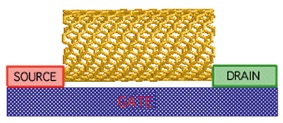



Connections Through Time, Issue 17: October
- December 2002
![]()
| ...it is a mere question of time when men
will succeed in attaching their machinery to the very wheelwork of nature.
Nikola Tesla addressing the American Institute of Electrical Engineers in 1891 |
 |
|
Carbon Nanotube technology can be used to create transistors and offers amazing possibilities to create future nanoelectronics devices, circuits, and computers. See Nasa Ref. |
NanoTechnology refers to the controlled manipulation of materials at the atomic or molecular level. The name comes from the length of a nanometer (nm) which is a billionth of a meter. On this scale, the thickness of a human hair is huge - between 100,000 and 200,000 nm thick. A typical virus is roughly 100 nm wide. Atoms themselves are typically 0.1 to 0.5 nm wide. Nanotechnology involves building "things" roughly in the range of 100 nm or less.
Nanotechnology was first discussed in 1959 by Richard Feyman, the famous Caltech physicist, in a talk at Caltech entitled, "There's Plenty of Room at the Bottom: An invitation to Enter a New Field of Physics".
The United States government, through its National Nanotechnology Initiative, has invested over $1 billion in this area since the year 2000 through 10 Departments and Agencies. Additional nanotechnology funding is, of course, being provided by other governments and by many private companies. Many believe that this field will become one of the biggest industries in our future - time will tell.
| CNT exhibits extraordinary mechanical properties: It is stiff as diamond and has very high tensile strength. These properties are ideal for nanoelectromechanical systems (NEMS), including nano-gears and nano-transistors. See Nasa Ref. |
Currently, real world applications of nanotechnology include:
As our ability to create nano-computers and nano-devices improves, we wonder if
/how/when nanotechnology will be used to tap into the Zero Point Energy (ZPE) field. The ZPE field, which arises from innate quantum fluctuations, contains an almost unlimited amount of potential energy that is built into the very fabric of space-time itself. Can nanotechnology and ZPE be the answer to the energy crisis? Can they be used to create a new efficient type of propulsion system for local travel and for exploring our universe? Many people, companies, universities and governments believe that the answer is yes to these questions as illustrated by the following research/development:There is still a long way to go until the dream of "free energy" becomes a reality. This dream goes back a long way - Nikola Tesla addressing the American Institute of Electrical Engineers in 1891, said:
Ere many generations pass, our machinery will be driven by a power
obtainable at any point in the universe.
This idea is not novel... We find it in the delightful myth of Antheus, who
derives power from the earth; we find it among the subtle speculations of one of
your splendid mathematicians... Throughout space there is energy. Is this
energy static or kinetic.? If static our hopes are in vain; if kinetic - and
this we know it is, for certain - then it is a mere question of time when men
will succeed in attaching their machinery to the very wheelwork of nature.
References
Practical Nanotechnology August 5, 2002
Nanotechnology:
the Coming Revolution in Molecular Manufacturing
The
Amazing Vanishing Transistor Act October 2002 Medical
Applications of Nanotechnology: Nanobodies Quantum
fluctuations of empty space: A new Rosetta Stone in physics? Dr.
Harold Puthoff The
Energetic Vacuum: Implications For Energy Research Dr. Harold Puthoff "NASA
Breakthrough Propulsion Physics Workshop Proceedings,"
NASA/CP-1999-208694, Proceedings of a conference held at and sponsored by NASA
Lewis Research Center in Cleveland Ohio, August 12-14, 1997. (Jan. 99) (456 pg.) Casimir
Force - First Precise Measurement December 20, 1996 Measurement of
Repulsive Quantum Vacuum Forces Uses nanotechnology developed for
MicroElectro-Mechanical Systems to do the measurements. 37th Joint
Propulsion Conference, Salt Lake City, July 8, 2001, Molecular wheel gets
a brake: Switch turns microscopic motor on and off.
30 October 2002, Full technical article is Control
of a biomolecular motor-powered nanodevice with an engineered chemical switch
Testing New Physics With Nothing October 29, 2002
Go to another section of
this
issue:
Intuition: Knowing
Applications: Intuition Exploration (InE) with
Feedback
![]()